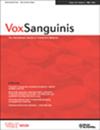人类免疫缺陷病毒相关血栓性血小板减少性紫癜中的 ADAMTS13 自身抗体
IF 1.8
4区 医学
Q3 HEMATOLOGY
引用次数: 0
摘要
背景与目的血栓性血小板减少性紫癜(TTP)是一种可能致命的血栓性微血管病变疾病,可由人类免疫缺陷病毒(HIV)感染引起。其发病机制包括缺乏冯-威廉因子(von Willebrand factor,vWF)裂解蛋白酶 ADAMTS13(一种具有凝血酶原基序的崩解蛋白和金属蛋白酶,成员 13)以及存在抗 ADAMTS13 自身抗体。然而,有关这些自身抗体的表位特异性和反应性的信息尚不充分。本研究旨在进行表位图谱分析,为了解受自身抗体影响的ADAMTS13结构域上的特异性表位提供新的视角。材料与方法 本研究分析了南非59例HIV相关TTP患者的冰冻柠檬酸盐血浆样本,使用Technozyme® ADAMTS13活性测试检测ADAMTS13活性,使用ELISA试剂盒检测总免疫球蛋白(Ig)M和IgA抗体水平,并使用NAb™蛋白G旋转柱纯化IgG抗体。结果总的来说,90%的样本都出现了抗 ADAMTS13 IgG 自身抗体,其中 64% 的抗体具有抑制作用,这是由混合研究显示的。ADAMTS13抗原水平低于5%的样本抗ADAMTS13 IgG自身抗体滴度较高(≥50 IU/mL),而ADAMTS13抗原水平为5%-10%的样本自身抗体滴度较低(50 IU/mL)。金属蛋白酶、富半胱氨酸和间隔域100%参与了抗ADAMTS13 IgG抗体的结合,58%的样本含有与ADAMTS13崩解素样结构域C末端部分结合的抗体,这表明致病机制不同。这些发现表明,ADAMTS13的蛋白水解活性可能会受到影响,从而凸显了相关致病机制的复杂性。本文章由计算机程序翻译,如有差异,请以英文原文为准。
Autoantibodies to ADAMTS13 in human immunodeficiency virus‐associated thrombotic thrombocytopenic purpura
Background and ObjectivesThrombotic thrombocytopenic purpura (TTP) is a potentially fatal thrombotic microangiopathic disorder that can result from human immunodeficiency virus (HIV) infection. The pathogenesis involves a deficiency of the von Willebrand factor (vWF) cleaving protease ADAMTS13 (a disintegrin and metalloprotease with thrombospondin motifs member 13) and the presence of anti‐ADAMTS13 autoantibodies. However, there is insufficient information regarding the epitope specificity and reactivity of these autoantibodies. This study aimed to perform epitope‐mapping analysis to provide novel insights into the specific epitopes on ADAMTS13 domains affected by autoantibodies.Materials and MethodsThe study analysed 59 frozen citrate plasma samples from HIV‐associated TTP patients in South Africa, measuring ADAMTS13 activity using Technozyme® ADAMTS13 activity test, total immunoglobulin (Ig) M and IgA antibodies levels using ELISA kit and purifying IgG antibodies using NAb™ Protein G spin columns. A synthetic ADAMTS13 peptide library was used for epitope mapping.ResultsOverall, 90% of samples showed anti‐ADAMTS13 IgG autoantibodies, with 64% of these antibodies being inhibitory, as revealed by mixing studies. Samples with ADAMTS13 antigen levels below 5% showed high anti‐ADAMTS13 IgG autoantibody titres (≥50 IU/mL), whereas those with 5%–10% levels had low autoantibody titres (<50 IU/mL).The metalloprotease, cysteine‐rich and spacer domains were 100% involved in binding anti‐ADAMTS13 IgG antibodies, with 58% of samples containing antibodies binding to the C‐terminal part of the ADAMTS13 disintegrin‐like domain, indicating different pathogenic mechanisms.ConclusionThe metalloprotease, cysteine‐rich and spacer domains are the primary targets for anti‐ADAMTS13 IgG autoantibodies in patients with HIV‐associated TTP. These findings suggest potential effects on the proteolytic activity of ADAMTS13, highlighting the complex nature of the pathogenic mechanisms involved.
求助全文
通过发布文献求助,成功后即可免费获取论文全文。
去求助
来源期刊

Vox Sanguinis
医学-血液学
CiteScore
4.40
自引率
11.10%
发文量
156
审稿时长
6-12 weeks
期刊介绍:
Vox Sanguinis reports on important, novel developments in transfusion medicine. Original papers, reviews and international fora are published on all aspects of blood transfusion and tissue transplantation, comprising five main sections:
1) Transfusion - Transmitted Disease and its Prevention:
Identification and epidemiology of infectious agents transmissible by blood;
Bacterial contamination of blood components;
Donor recruitment and selection methods;
Pathogen inactivation.
2) Blood Component Collection and Production:
Blood collection methods and devices (including apheresis);
Plasma fractionation techniques and plasma derivatives;
Preparation of labile blood components;
Inventory management;
Hematopoietic progenitor cell collection and storage;
Collection and storage of tissues;
Quality management and good manufacturing practice;
Automation and information technology.
3) Transfusion Medicine and New Therapies:
Transfusion thresholds and audits;
Haemovigilance;
Clinical trials regarding appropriate haemotherapy;
Non-infectious adverse affects of transfusion;
Therapeutic apheresis;
Support of transplant patients;
Gene therapy and immunotherapy.
4) Immunohaematology and Immunogenetics:
Autoimmunity in haematology;
Alloimmunity of blood;
Pre-transfusion testing;
Immunodiagnostics;
Immunobiology;
Complement in immunohaematology;
Blood typing reagents;
Genetic markers of blood cells and serum proteins: polymorphisms and function;
Genetic markers and disease;
Parentage testing and forensic immunohaematology.
5) Cellular Therapy:
Cell-based therapies;
Stem cell sources;
Stem cell processing and storage;
Stem cell products;
Stem cell plasticity;
Regenerative medicine with cells;
Cellular immunotherapy;
Molecular therapy;
Gene therapy.
 求助内容:
求助内容: 应助结果提醒方式:
应助结果提醒方式:


